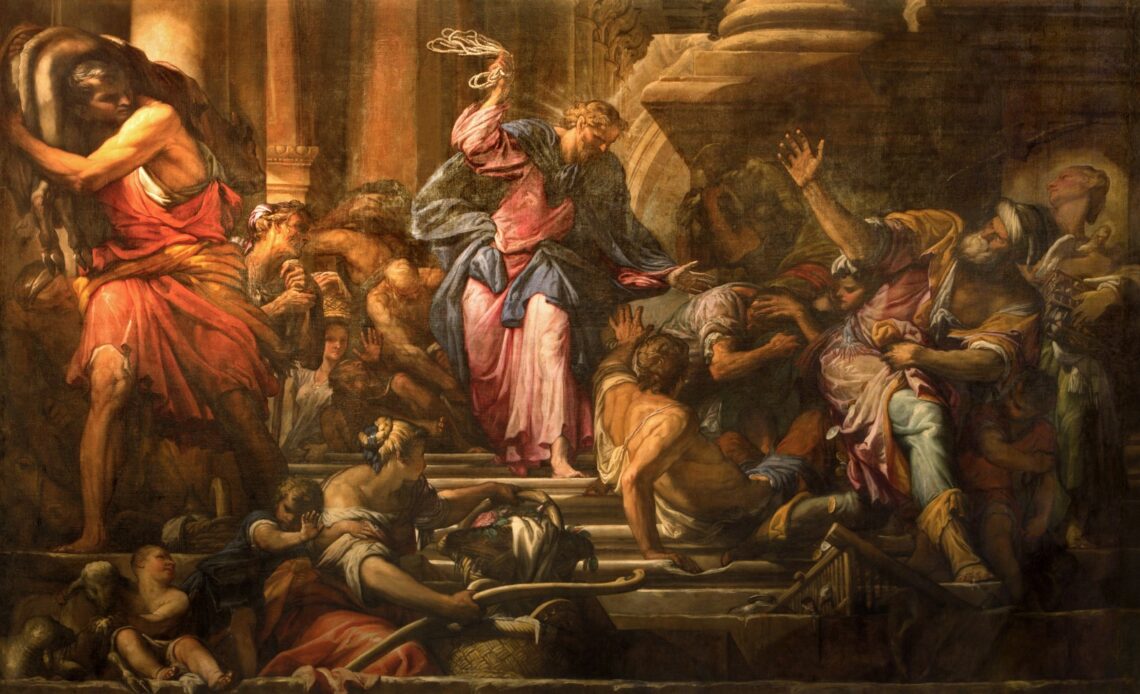The observance of Holy Monday has changed significantly over the years. Based on history, we know that Holy Week as we currently celebrate it has changed a lot over the centuries. Initially, the only two days that were observed during Holy Week celebrations were Good Friday and Holy Saturday. Sometime after the third century, Holy Wednesday was added to the liturgical calendar, commemorating the day that Judas betrayed Christ into the hands of the Romans. It wasn’t until Saint Athansius, the bishop of Alexandria, and Saint Epiphanus of Constantia came together to expand Holy Week that the Church started observing it as we do today.
It’s easy to become focused on the days of Holy Week that we consider to be more important than others. Obviously, Good Friday commemorates the crucifixion of Christ, and Easter Sunday is the celebration of His triumphant resurrection. Palm Sunday is an important part of the Holy Week story, as it included the fulfillment of prophecies, and further revealed the heart of God to His people. Unfortunately, Holy Monday often gets glossed over. Even though it’s not the day that Judas betrayed Jesus, Jesus was arrested, or the day that Christ raised from the dead, the Bible does teach us about a few things that took place on the day following Palm Sunday.
Today, let’s take a deeper dive into some of the events that transpired on the first Holy Monday as Christ prepared Himself and His disciples for the first Easter weekend.
Jesus Cleanses the Temple
Matthew 21:12-13 (NIV)
Jesus entered the temple courts and drove out all who were buying and selling there. He overturned the tables of the money changers and the benches of those selling doves. “It is written,” he said to them, “’My house will be called a house of prayer, but you are making it a den of robbers.’”
It often comes as a surprise, but one of the first emotions that Christ exhibited after arriving in Jerusalem was anger. On the first Holy Monday, everyone in town was preparing for the Passover celebration. This involved making sure that they had the animal sacrifices that had been a part of the Jewish custom since the very first Passover in the Book of Exodus, some 1600-plus years before the events that we’re reading about today.
Unfortunately, there were people who saw this as an opportunity to take advantage of others. Since there were strict requirements in place that dictated the type of animal that each family would sacrifice, its age, and physical appearance, some people decided to set up in the temple so they could charge exorbitant amounts for these sacrificial animals. Christ was outraged.
This is about much more than Jesus not wanting our relationship with God to be a business agreement. Instead, it serves as another example of His commitment to caring for those who are disadvantaged and victimized.
History teaches us that it wasn’t uncommon for government funds to be kept in the temple, as there were no banks in those days. Pharisaical leaders would often lend money to poor people at excessively high interest rates so they could make money off of those who had no money to begin with. When the borrower couldn’t pay, the religious leaders would seize their land, livestock, and other belongings.
Filled with a righteous indignation, Jesus chased the swindlers out of the temple with a whip that He made on the spot. He flipped over their tables, shutting their business down. He then saw the blind, deaf, and lame who had come to the temple. He knew they would have been taken advantage of had He not shown up. So, He healed them. There was no transaction, just grace.
In that moment, Jesus erased the divide that stood between those who struggled to find their religious footing and those who stood at the top of the mountain. This was foreshadowing what was going to happen on Good Friday when the veil of the temple was torn from top to bottom.
Jesus Curses the Fig Tree
Matthew 21:18-19 (NIV)
Early in the morning, as Jesus was on his way back to the city, he was hungry. Seeing a fig tree by the road, he went up to it but found nothing on it except leaves. Then he said to it, “May you never bear fruit again!” Immediately the tree withered.
Shortly after Jesus had thrown the moneychangers out of the temple, He and the disciples moved on. During the walk, Jesus got hungry and decided to check one of the fig trees that grew abundantly along the side of the road in Jerusalem. In order to fully understand this story, there are some historical contexts to consider.
Based on the time of year when this story took place, most fig trees wouldn’t be bearing fruit. However, this tree looked different. It had something that the other fig trees didn’t have yet: leaves. On the outside, the tree looked like it was going to meet the expectations of Christ. Unfortunately, when Jesus took a closer look, the tree was all flash and no substance.
Jesus’ decision to curse the fig tree, resulting in its withering from the roots, seems out of character. This was the same Jesus who had just had compassion on the blind and deaf in the temple. The same Jesus who welcomed children into His presence had now cursed a tree, resulting in its eternal fruitlessness. What was the meaning of this?
While Jesus used this interaction to teach the disciples a lesson on prayer, there’s also something for us to learn. The story of Easter isn’t just meant to make us look good in our finest Easter outfit. Instead, it’s meant to change us from the inside out so we can bear fruit. The religious leaders in the temple looked good on the outside, but they were dried up and dead inwardly. Let us not become like them.
The Question of Christ’s Authority
Matthew 21:23 (NIV)
Jesus entered the temple courts, and, while he was teaching, the chief priests and the elders of the people came to him. “By what authority are you doing these things?” they asked. “And who gave you this authority?”
Things were coming to a head between Jesus and the religious leaders of the time. They had never been big fans of Christ. Things were getting even more tense after Jesus had shut down their moneymaking schemes in the temple. Who did He think He was?!
This interaction is easy to miss when reading about the events of Holy Week because there isn’t a lot of action. The chief priests who would eventually involve themselves in the crucifixion asked Jesus a question, and He gave them an answer that turned the tables. Who gave John the Baptist authority to baptize people?
The religious leaders were trapped. If they said that John acted on the authority of God, it gave credence to Christ’s claims. If they said that John was acting on his own authority, the people would kill them. Once again, Jesus established that they would not entrap Him in anything, and things were going to work according to God’s timing.
God’s sovereignty still applies to us. When it seems like everything is falling apart, He’s actually holding everything together. Holy Week is perhaps the most powerful example of this concept.
A Closing Prayer:
Heavenly Father, help me to focus even more on You during this Holy Week. Turn my heart to those who are struggling, and give me compassion for them. Help me to bear the fruits that You want me to bear. Most of all, help me to fully rely on Your perfect timing and Your sovereignty in every situation. In Christ’s name, Amen.


